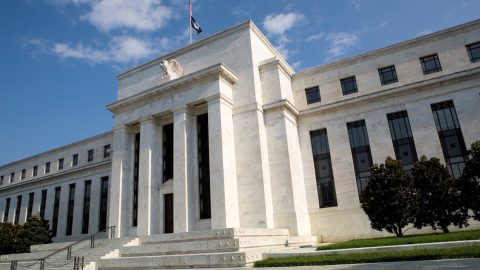Interest rate decision by the Fed
Tomorrow, Thursday 17 September 2015, the federal Open Market Committee (FOMC) of the US central bank Fed will be taking an important decision. Is the Fed funds rate to be raised or not? The financial markets have accorded this decision a particularly important role. After all, the rate hike by the most important central bank in the world could cause the degree of instability on the financial market to continue rising.
Regardless of whether or not a rate hike materialises, the Fed will communicate that the interest rate cycle will only be set off very gradually. At the same time, the projection for the final level of the cycle will probably be taken down a bit. If the Fed managed to alleviate the worries of excessive rate hikes, a slight increase of the Fed funds rate on coming Thursday would not upset the financial markets in any sustainable fashion. However, the weakest segments in the emerging countries would come under pressure.
Start, speed, and finish
Much like the economic cycle, the development of the key-lending rate (here: Fed funds rate) is not erratic, but follows trends. The last cycle of rate hikes started in 2004 at 1% and ended in 2006 at 5.25%. The question is therefore whether the Fed funds rate will be raised in September, a bit later, or remain at practically zero in the foreseeable future. This is the signalling effect of the first interest step: the uncertainty with regard to the speed and the final point of the interest rate cycle.
Neutral interest level
Traditionally an interest rate cycle that originates at a low level is referred to as normalisation. This is the process of approximation towards the so-called neutral interest level, which is the level at which the economy is in equilibrium. Numerous estimates suggest an equilibrium bandwidth of 3% to 3.5%. In this model the economic resources labour and capital are used optimally. This goes for the level of goods and services produced (potential output) and for economic growth (potential growth). Put simply, this is a situation of full employment. Also, the rate of inflation is in line with the target of the central bank (2%).
FED Funds Rate 2000 – 2015 (in %)

Improvement on the labour market
The current fed funds rate is within a bandwidth of 0% to 0.25% and was set at the climax of the recent crisis, at the end of 2008. The reason for a near-zero percent interest policy has subsided somewhat in line with the slow, weak, and fragile recovery of the US economy from the Great Recession 2008/2009. Indeed, the unemployment rate is now at 5.1%. Some estimates suggest that therefore an important threshold may have been hit, i.e. the so-called non-accelerating inflation rate of unemployment (NAIRU). In this model, the pressure of excessive wage and price increases rises for values below that threshold. However, there are also other job market indicators that suggest significant amounts of underemployment. Also, at 1.2%, the inflation measure preferred by the Fed, the deflator for private consumer spending exclusive of food and energy (core personal consumption expenditure deflator) fell clearly short of the inflation target of 2% in July on a year-on-year basis. At +2.1%, however, the growth rate of GDP adjusted for inflation exceeded the estimated potential growth rate of about +1.8% in the first half of 2015 (Source: Bloomberg). If the economy continues to grow above its potential, inflation pressure will decline over time according to the aforementioned theory. Given this scenario, numerous FOMC members have recently expressed their tightening bias and thus to be in favour of a rate hike in the foreseeable future.
Problems in the emerging economies
In many emerging countries, which account for a total of about 40% of the global economy, a negative spiral has been set off. Weaker economic growth and at the same time a drastic increase in private debt has caused capital outflows, which in turn have led to the depreciation of currencies and a reduction in liquidity (rising interest rates, more restrictive lending standards of banks, more difficult access to the capital market). Coming full circle, this environment then weighs on economic activity.
Negative spill-over effects
The weakness in the emerging economies also spills over into the US economy. The financial conditions deteriorate: the spreads for the default and liquidity risk and volatility have increased, and share prices have fallen. A further deterioration would burden the US economy significantly and for the longer term. Also, the sentiment of consumers and companies might deteriorate. This would cause private consumption and investment to decline. Thirdly, the emerging markets have been generating pressure for prices to fall (deflation). The currencies of the emerging markets, commodity prices, and the global prices of goods are caught in a falling trend. This has led to declining import and producer prices in the USA, which keep the entire inflation pressure on low levels. And lastly, the direct effects via lower US exports are minimal.
Conclusion
The Fed therefore has to evaluate two spheres that influence each other. The US economic growth is gradually turning self-supporting and causes the economy to edge towards full employment and inflation target. At the same time the weakening in the emerging economies is producing deflation pressure on a global scale as well as an increase in instability on the financial market.
In summary, it is not clear whether or not the Fed funds rate will be raised on coming Thursday. That being said, a push-back would be of very limited help because the opposing developments will probably be picking up. The resulting uncertainty with regard to the starting point of the interest rate cycle would continue to affect the financial markets. The maintenance of the current rate level would only make sense from a rational point of view if the tightening bias were to subside as well – which is not very likely. Regardless of whether or not a rate hike materialises, the Fed will communicate that the interest rate cycle will only be set off very gradually. At the same time, the projection for the final level of the cycle will probably be taken down a bit. If the Fed managed to alleviate the worries of excessive rate hikes, a slight increase of the Fed funds rate on coming Thursday would not upset the financial markets in any sustainable fashion. However, the weakest segments would come under pressure.
Legal disclaimer
This document is an advertisement. Unless indicated otherwise, source: Erste Asset Management GmbH. The language of communication of the sales offices is German and the languages of communication of the Management Company also include English.
The prospectus for UCITS funds (including any amendments) is prepared and published in accordance with the provisions of the InvFG 2011 as amended. Information for Investors pursuant to § 21 AIFMG is prepared for the alternative investment funds (AIF) administered by Erste Asset Management GmbH pursuant to the provisions of the AIFMG in conjunction with the InvFG 2011.
The currently valid versions of the prospectus, the Information for Investors pursuant to § 21 AIFMG, and the key information document can be found on the website www.erste-am.com under “Mandatory publications” and can be obtained free of charge by interested investors at the offices of the Management Company and at the offices of the depositary bank. The exact date of the most recent publication of the prospectus, the languages in which the fund prospectus or the Information for Investors pursuant to Art 21 AIFMG and the key information document are available, and any other locations where the documents can be obtained are indicated on the website www.erste-am.com. A summary of the investor rights is available in German and English on the website www.erste-am.com/investor-rights and can also be obtained from the Management Company.
The Management Company can decide to suspend the provisions it has taken for the sale of unit certificates in other countries in accordance with the regulatory requirements.
Note: You are about to purchase a product that may be difficult to understand. We recommend that you read the indicated fund documents before making an investment decision. In addition to the locations listed above, you can obtain these documents free of charge at the offices of the referring Sparkassen bank and the offices of Erste Bank der oesterreichischen Sparkassen AG. You can also access these documents electronically at www.erste-am.com.
Our analyses and conclusions are general in nature and do not take into account the individual characteristics of our investors in terms of earnings, taxation, experience and knowledge, investment objective, financial position, capacity for loss, and risk tolerance. Past performance is not a reliable indicator of the future performance of a fund.
Please note: Investments in securities entail risks in addition to the opportunities presented here. The value of units and their earnings can rise and fall. Changes in exchange rates can also have a positive or negative effect on the value of an investment. For this reason, you may receive less than your originally invested amount when you redeem your units. Persons who are interested in purchasing units in investment funds are advised to read the current fund prospectus(es) and the Information for Investors pursuant to § 21 AIFMG, especially the risk notices they contain, before making an investment decision. If the fund currency is different than the investor’s home currency, changes in the relevant exchange rate can positively or negatively influence the value of the investment and the amount of the costs associated with the fund in the home currency.
We are not permitted to directly or indirectly offer, sell, transfer, or deliver this financial product to natural or legal persons whose place of residence or domicile is located in a country where this is legally prohibited. In this case, we may not provide any product information, either.
Please consult the corresponding information in the fund prospectus and the Information for Investors pursuant to § 21 AIFMG for restrictions on the sale of the fund to American or Russian citizens.
It is expressly noted that this communication does not provide any investment recommendations, but only expresses our current market assessment. Thus, this communication is not a substitute for investment advice.
This document does not represent a sales activity of the Management Company and therefore may not be construed as an offer for the purchase or sale of financial or investment instruments.
Erste Asset Management GmbH is affiliated with the Erste Bank and austrian Sparkassen banks.
Please also read the “Information about us and our securities services” published by your bank.



